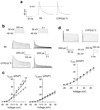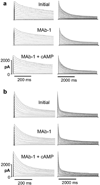Electrophysiological properties of cardiomyocytes isolated from CYP2J2 transgenic mice
- PMID: 17652182
- PMCID: PMC2243182
- DOI: 10.1124/mol.107.035881
Electrophysiological properties of cardiomyocytes isolated from CYP2J2 transgenic mice
Abstract
CYP2J2 is abundant in cardiac tissue and active in the biosynthesis of eicosanoids such as epoxyeicosatrienoic acids (EETs). To determine the effects of CYP2J2 and its eicosanoid products in the heart, we characterized the electrophysiology of single cardiomyocytes isolated from adult transgenic (Tr) mice with cardiac-specific overexpression of CYP2J2. CYP2J2 Tr cardiomyocytes had a shortened action potential. At 90% repolarization, the action potential duration (APD) was 30.6 +/- 3.0 ms (n = 22) in wild-type (Wt) cells and 20.2 +/- 2.3 ms (n = 19) in CYP2J2 Tr cells (p < 0.005). This shortening was probably due to enhanced maximal peak transient outward K(+) currents (I(to,peak)), which were 38.6 +/- 2.8 and 54.4 +/- 4.9 pA/pF in Wt and CYP2J2 Tr cells, respectively (p < 0.05). In contrast, the late portion of the transient outward K(+) current (I(to,280ms)), the slowly inactivating outward K(+) current (I(K,slow)), and the voltage-gated Na(+) current (I(Na)) were not significantly altered in CYP2J2 Tr cells. N-Methylsulphonyl-6-(2-proparglyloxy-phenyl)hexanamide (MS-PPOH), a specific inhibitor of EET biosynthesis, significantly reduced I(to,peak) and increased APD in CYP2J2 Tr cardiomyocytes but not in Wt cells. Intracellular dialysis with a monoclonal antibody against CYP2J2 also significantly reduced I(to,peak) and increased APD in CYP2J2 Tr cardiomyocytes. Addition of 11,12-EET or 8-bromo-cAMP significantly reversed the MS-PPOH- or monoclonal antibody-induced changes in I(to,peak) and APD in CYP2J2 Tr cells. Together, our data demonstrate that shortening of the action potential in CYP2J2 Tr cardiomyocytes is associated with enhanced I(to,peak) via an EET-dependent, cAMP-mediated mechanism.
Figures







Similar articles
-
Enhancement of cardiac L-type Ca2+ currents in transgenic mice with cardiac-specific overexpression of CYP2J2.Mol Pharmacol. 2004 Dec;66(6):1607-16. doi: 10.1124/mol.104.004150. Epub 2004 Sep 10. Mol Pharmacol. 2004. PMID: 15361551
-
Enhanced postischemic functional recovery in CYP2J2 transgenic hearts involves mitochondrial ATP-sensitive K+ channels and p42/p44 MAPK pathway.Circ Res. 2004 Sep 3;95(5):506-14. doi: 10.1161/01.RES.0000139436.89654.c8. Epub 2004 Jul 15. Circ Res. 2004. PMID: 15256482
-
CYP2J2-derived epoxyeicosatrienoic acids suppress endoplasmic reticulum stress in heart failure.Mol Pharmacol. 2014 Jan;85(1):105-15. doi: 10.1124/mol.113.087122. Epub 2013 Oct 21. Mol Pharmacol. 2014. PMID: 24145329 Free PMC article.
-
Cyclic AMP-dependent modulation of cardiac L-type Ca2+ and transient outward K+ channel activities by epoxyeicosatrienoic acids.Prostaglandins Other Lipid Mediat. 2007 Jan;82(1-4):11-8. doi: 10.1016/j.prostaglandins.2006.05.023. Epub 2006 Jul 7. Prostaglandins Other Lipid Mediat. 2007. PMID: 17164128 Review.
-
CYP2J2-mediated metabolism of arachidonic acid in heart: A review of its kinetics, inhibition and role in heart rhythm control.Pharmacol Ther. 2024 Jun;258:108637. doi: 10.1016/j.pharmthera.2024.108637. Epub 2024 Mar 22. Pharmacol Ther. 2024. PMID: 38521247 Review.
Cited by
-
Regulation of CYP2J2 and EET Levels in Cardiac Disease and Diabetes.Int J Mol Sci. 2018 Jun 29;19(7):1916. doi: 10.3390/ijms19071916. Int J Mol Sci. 2018. PMID: 29966295 Free PMC article. Review.
-
Transcription factors MYOCD, SRF, Mesp1 and SMARCD3 enhance the cardio-inducing effect of GATA4, TBX5, and MEF2C during direct cellular reprogramming.PLoS One. 2013 May 21;8(5):e63577. doi: 10.1371/journal.pone.0063577. Print 2013. PLoS One. 2013. PMID: 23704920 Free PMC article.
-
Evidence for role of epoxyeicosatrienoic acids in mediating ischemic preconditioning and postconditioning in dog.Am J Physiol Heart Circ Physiol. 2009 Jul;297(1):H47-52. doi: 10.1152/ajpheart.01084.2008. Epub 2009 May 15. Am J Physiol Heart Circ Physiol. 2009. PMID: 19448143 Free PMC article.
-
Role of Arginine 117 in Substrate Recognition by Human Cytochrome P450 2J2.Int J Mol Sci. 2018 Jul 16;19(7):2066. doi: 10.3390/ijms19072066. Int J Mol Sci. 2018. PMID: 30012976 Free PMC article.
-
Cytochrome P450 2J2 is protective against global cerebral ischemia in transgenic mice.Prostaglandins Other Lipid Mediat. 2012 Dec;99(3-4):68-78. doi: 10.1016/j.prostaglandins.2012.09.004. Epub 2012 Oct 2. Prostaglandins Other Lipid Mediat. 2012. PMID: 23041291 Free PMC article.
References
-
- Alvarez J, Montero M, Garcia-Sancho J. Cytochrome P450 may regulate plasma membrane Ca2+ permeability according to the filling state of the intracellular Ca2+ stores. FASEB J. 1992;6:786–792. - PubMed
-
- Anderson AE, Adams JP, Qian Y, Cook RG, Pfaffinger PJ, Sweatt JD. Kv4.2 phosphorylation by cyclic AMP-dependent protein kinase. J Biol Chem. 2000;275:5337–5346. - PubMed
-
- Brand-Schieber E, Falck JF, Schwartzman M. Selective inhibition of arachidonic acid epoxidation in vivo. J Physiol Pharmacol. 2000;51:655–672. - PubMed
-
- Campbell WB, Gebremedhin D, Pratt PF, Harder DR. Identification of epoxyeicosatrienoic acids as endothelium-derived hyperpolarizing factors. Circ Res. 1996;78:415–423. - PubMed
-
- Carroll MA, Doumad AB, Li J, Cheng MK, Falck JR, McGiff JC. Adenosine2A receptor vasodilation of rat preglomerular microvessels is mediated by EETs that activate the cAMP/PKA pathway. Am J Physiol Renal Physiol. 2006;291:F155–F161. - PubMed
Publication types
MeSH terms
Substances
Grants and funding
LinkOut - more resources
Full Text Sources
Other Literature Sources
Molecular Biology Databases

